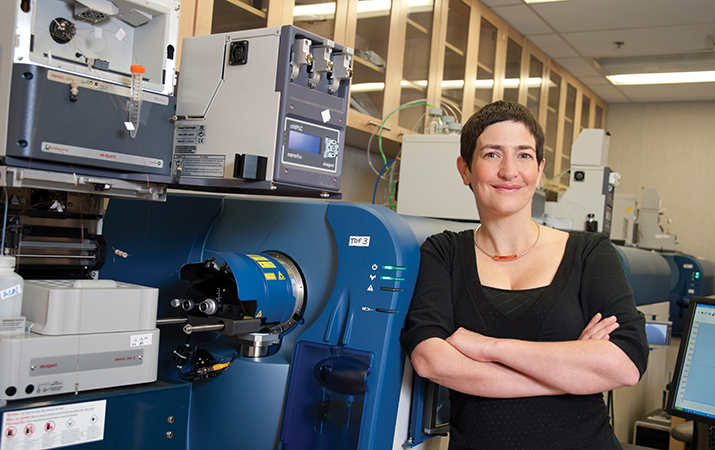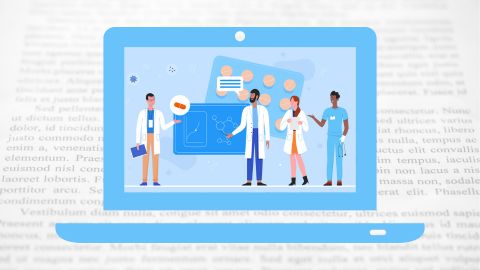Meet Anne-Claude Gingras
Anne-Claude Gingras is a senior investigator at the Lunenfeld–Tanenbaum Research Institute in Canada. Gingras started her lab at the institute in late 2005 and has won several awards for her research involving signal transduction and mass spectrometry. In addition to her role as a senior investigator, she is a director of the institute’s proteomics group. This past fall, she and Steven A. Carr at the Broad Institute became deputy editors at the journal Molecular & Cellular Proteomics, where the current editor-in-chief is Al Burlingame at the University of California, San Francisco. Gingras spoke with John Arnst, ASBMB Today’s science writer. The interview has been edited for clarity and length.
 Anne-Claude GingrasPHOTO COURTESY OF ANNE-CLAUDE GINGRAS
Anne-Claude GingrasPHOTO COURTESY OF ANNE-CLAUDE GINGRAS
What is your group working on?
My research is mostly focused on understanding how proteins essentially associate with one another to perform their activities and how these associations are perturbed by changes in the signals that the cells would receive. I’m also a full professor at the University of Toronto.
What was your research training?
I did my Ph.D. at McGill University in the department of biochemistry. I worked on translation initiation. I was characterizing how a certain translation inhibitor called 4E-BP1 was able to receive signals from the insulin and growth receptor pathways to regulate translation initiation. This process is involved in different cancers and neurodegenerative diseases, and it’s also targeted by viruses.
I graduated in 2001, and I started my postdoc in 2002. I wanted to do more of a technical postdoc, as I had a pretty good basis in fundamental biochemistry. I decided go to the lab of Ruedi Aebersold, who, at the time, was in Seattle. Ruedi was a rising star in proteomics. Now he’s at the top of the world. He had just published a proteomics method called ICAT that enabled researchers to compare the abundance of peptides in two samples. What I wanted to do was to continue to work on the characterization of signaling pathways that impinge on translation but bring a proteomics component to it. I started in Ruedi’s lab in 2002, and I worked there for just over three years.
What made you choose science as a career?
I did my bachelor’s (degree) in Quebec City at the University Laval. It was in biochemistry. I worked in the lab one summer before the school year, and I realized I wanted to do research as a career. The mentor whom I had in the lab, André Darveau, was fantastic and spent a lot of time training me. He’s now the dean of the science and engineering faculty at Laval University.
After that, I realized that I probably should learn English. I thought McGill was a good compromise, because in Montreal, you can still live in French and work in English. I did my Ph.D. with Nahum Sonenberg. Nahum’s lab had discovered the internal ribosomal entry site that many viruses use to initiate the translation of their own proteins. He had also discovered and cloned eIF4E, the protein that binds to the cap structure of the cellular mRNAs.
At the time when I joined, the lab had just cloned the first two inhibitors of translation that block the action of eIF4E. Arnim Pause, the student who cloned it, was leaving for his postdoc. I was lucky. I walked in the lab, and they said, “OK, new girl, your job is to finish the experiments for that paper that we’re going to be submitting.” They submitted it to Nature a few weeks after I started in the lab. When the paper came back, I had to help with the revisions, so I got to be on a Nature paper within a few months. It was really cool, and it was super motivating. Of course that didn’t happen every week after that.
One of the things that I learned from Nahum is if you have somebody in your lab who’s good, you need to let them come up with their own ideas and try them, because any given person will only have a limited number of good ideas. Nahum would leave the students and postdocs to essentially come up with crazy ideas and test them.
We had a case where we needed to map phosphorylation sites. There was this new professor at the time in Vancouver, who was Ruedi. (Author’s note: Ruedi Aebersold was at the University of British Columbia from 1989 to 1993.) We sent him some of our samples to do Edman degradation, and that’s how I got connected (with Ruedi). We then collaborated on several projects, eventually using mass spectrometry to study phosphorylation of 4E-BP1 and other proteins. That got me very interested in proteomics, and I knew I really liked Ruedi personally, so the decision to do my postdoc there was quite natural. I never applied for any other postdoc position, never went to an interview or anything like that, so it’s quite unusual in that way. I felt like that was the right thing for me to do at the time.
Do you have any words of wisdom or a favorite motto for scientists in training?
There is one thing that I tell them: Be nice to everyone, because this is a very small world. If somebody needs help, try to guide them the best way you can, whether it’s somebody in another lab or elsewhere. It’s going to be these people coming back in your life later on.
I think when people join a lab after doing a Ph.D., sometimes they’ve been in a place where they were told to be selfish. It’s such a collaborative world right now. The sooner you learn to be nice to people and work well with people and to share everything — the credit for intellectual contribution and reagents — everybody wins.
How’s the new role at MCP going so far?
Having Steve and me joining at the same time is really good, because it enables us to re-energize and rethink the structure of the journal. Al has been really open to work as a trio of editor-in-chief and deputy editors, so it’s been great so far. I think it’s going to keep getting better.
What was your involvement with MCP before?
I was one of the most used reviewers on the editorial board. I was dealing with a lot of the papers that had to do with protein interactions, cell biology and so on. And, of course, I was an author. I have several papers in MCP.
What was your reaction when they asked you to take over?
It caught me a little bit by surprise. My initial reaction was that I didn’t want to have any more work, but then I thought, “Yeah, I have some ideas of how to improve the journal. This is the best journal in the field, and it’s important for proteomics that people actually get involved and agree to step up and contribute.”
Do you have any hobbies, or advice for balancing life in the lab with life outside it?
My significant other is also a scientist running his lab. If anything, he works more than me. We don’t have a super balanced life. We do things like hiking, but we don’t have kids, so that makes it easier for me to commit to something else. That’s something that I fully realize is hard for some of my lab members with families.
I give a lot of courses, seminars and conference presentations abroad, so I travel several times a month outside of Toronto.
What’s the most interesting place you’ve traveled to in the last year?
Just a couple of weeks ago, I was in southern Chile in this nice area that’s north of Patagonia, with this beautiful volcano and lake. It was spring there, and it was beautiful. It’s a nice opportunity when you’re a scientist to travel to a lot of cool places, but it’s something that most people who have a normal job don’t get to do.
Enjoy reading ASBMB Today?
Become a member to receive the print edition monthly and the digital edition weekly.
Learn moreGet the latest from ASBMB Today
Enter your email address, and we’ll send you a weekly email with recent articles, interviews and more.
Latest in People
People highlights or most popular articles

2024 voter guide
Learn about the candidates running for ASBMB Council, Nominating Committee, Publications Committee and treasurer.

Charles O. Rock (1949 – 2023)
Colleagues and trainees remember a world expert in membrane lipid homeostasis.

Honors for Clemons, Hatzios and Wiemer
Awards, honors, milestones and more. Find out what's happening in the lives of ASBMB members.

Touching the future from the bench
Scholar, scientist, teacher and mentor Odutayo Odunuga discusses the important roles of the institutional PI, his journey and his research.

In memoriam: Darwin Prockop
He held leadership positions at multiple institutions and was known for his contributions to adult stem cell biology and cellular biology.

A look into medical writing
Our careers columnist spoke with Ashlea A. Morgan at Chameleon Communications International to get a sense of one type of work a medical writer can do.

